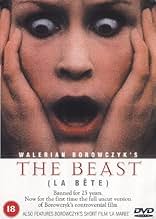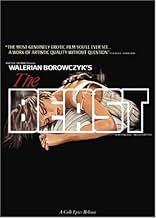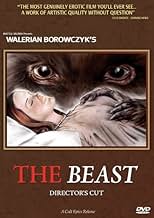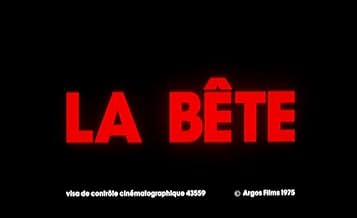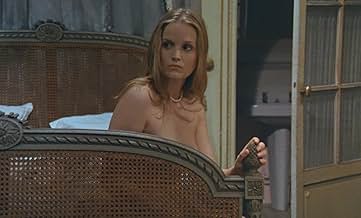IMDb RATING
5.7/10
5.7K
YOUR RATING
In order to inherit a fortune a young woman agrees to marry a young man. She soon discovers that his family harbours a dark past involving a monstrous beast.In order to inherit a fortune a young woman agrees to marry a young man. She soon discovers that his family harbours a dark past involving a monstrous beast.In order to inherit a fortune a young woman agrees to marry a young man. She soon discovers that his family harbours a dark past involving a monstrous beast.
Marcel Dalio
- Duc Rammendelo
- (as Dalio)
- Director
- Writer
- All cast & crew
- Production, box office & more at IMDbPro
Featured reviews
NOTE: This film was recommended to me by Zachary George Najarian-Najafi for "Steve Pulaski Sees It."
Walerian Borowczyk's La Bête is a seriously grotesque film, but unless you have the patience to make it through about an hour of glacially paced exposition, you won't realize why. In terms of going from zero to one-hundred in terms of plot-escalation, La Bête takes the cake with positioning itself like an ordinary, albeit slightly off-kilter, melodrama about an arranged relationship in a close-knit family, before becoming a zoophiliac's ultimate cinematic desire.
The story opens following the death of a businessman named Philip Broadhurst, who leaves his estate to his daughter Lucy (Lisbeth Hummel) with the only condition being that she be married to a man named Mathurin (Pierre Benedetti) by the brother of Pierre's uncle within the next six months. Despite Mathurin's mental deficiencies and deformities, Lucy still agrees to marry him, with her and her aunt Virginia (Elisabeth Kaza) taking a trip to the Pierre's brother's farmhouse. At the farmhouse, Lucy learns of a two-hundred-year-old fairytale about a beast living in the woods adjacent to the farmhouse.
For about an hour, we endure ostensibly neverending conversation between this enormous family-to-be, none of it really amounting to anything other than frustration due to the lack of human interest and a great deal of pointless sermonizing about family and the marital bond. It isn't until the hour mark that Borowczyk, also the screenwriter here, flips the switch and turns La Bête into something cruelly twisted. Without giving too much away, for much of the final thirty minutes of this film need be experienced, the film involves a dark, twisted dream sequence (or maybe not) of Lucy's intimate, sexual relationship with the aforementioned beast.
Borowczyk doesn't hold back in what he wants the audience to see in La Bête, so much so that he's willing to show us a bear ejaculating and performing cunnilingus on Lucy, resulting in Lucy enduring a series of bloody scratches. No taboo in beastiality is left untouched as the film details some of the most wicked sexual perversions you're likely to see come to life on screen in your life. Me being so young, I feel I have a ways to go, which only works to keep me up at night even more.
As an art film, La Bête is rather tasteful up until its final act. The film is nicely shot, with numerous, intimate camera angles taking the place of the predictable scuzzy aesthetic one would expect this film to have, in addition to having several nicely decorated sets and some solid exterior shots of the forest where much of this action happens. As a pornographic film, La Bête is most artful in a sense, but the porn itself is anything but erotic. It almost feels like shock value, especially when we must endure numerous closeups of a gigantic bear ejaculating repeatedly.
La Bête is a curious oddity, destined to gather dust on the seldom surviving, family-owned VHS stores where ultra-weird, almost unspeakable cult classic, and some just stopping at "cult," films precariously placed on towering shelves. I can almost envision an ordinary, black VHS tape with a color-faded, peeling white label with "The Beast" written in pencil, discolored and sun-damaged to look like simple hashmarks, sitting on the shelf looking unassuming and innocent but bearing quite the visual wallop. That's precisely what La Bête is; a visual wallop not for the faint of heart. I'm sure Lucy herself would say something similar.
Starring: Lisbeth Hummel, Pierre Benedetti, and Elisabeth Kaza. Directed by: Walerian Borowczyk.
Walerian Borowczyk's La Bête is a seriously grotesque film, but unless you have the patience to make it through about an hour of glacially paced exposition, you won't realize why. In terms of going from zero to one-hundred in terms of plot-escalation, La Bête takes the cake with positioning itself like an ordinary, albeit slightly off-kilter, melodrama about an arranged relationship in a close-knit family, before becoming a zoophiliac's ultimate cinematic desire.
The story opens following the death of a businessman named Philip Broadhurst, who leaves his estate to his daughter Lucy (Lisbeth Hummel) with the only condition being that she be married to a man named Mathurin (Pierre Benedetti) by the brother of Pierre's uncle within the next six months. Despite Mathurin's mental deficiencies and deformities, Lucy still agrees to marry him, with her and her aunt Virginia (Elisabeth Kaza) taking a trip to the Pierre's brother's farmhouse. At the farmhouse, Lucy learns of a two-hundred-year-old fairytale about a beast living in the woods adjacent to the farmhouse.
For about an hour, we endure ostensibly neverending conversation between this enormous family-to-be, none of it really amounting to anything other than frustration due to the lack of human interest and a great deal of pointless sermonizing about family and the marital bond. It isn't until the hour mark that Borowczyk, also the screenwriter here, flips the switch and turns La Bête into something cruelly twisted. Without giving too much away, for much of the final thirty minutes of this film need be experienced, the film involves a dark, twisted dream sequence (or maybe not) of Lucy's intimate, sexual relationship with the aforementioned beast.
Borowczyk doesn't hold back in what he wants the audience to see in La Bête, so much so that he's willing to show us a bear ejaculating and performing cunnilingus on Lucy, resulting in Lucy enduring a series of bloody scratches. No taboo in beastiality is left untouched as the film details some of the most wicked sexual perversions you're likely to see come to life on screen in your life. Me being so young, I feel I have a ways to go, which only works to keep me up at night even more.
As an art film, La Bête is rather tasteful up until its final act. The film is nicely shot, with numerous, intimate camera angles taking the place of the predictable scuzzy aesthetic one would expect this film to have, in addition to having several nicely decorated sets and some solid exterior shots of the forest where much of this action happens. As a pornographic film, La Bête is most artful in a sense, but the porn itself is anything but erotic. It almost feels like shock value, especially when we must endure numerous closeups of a gigantic bear ejaculating repeatedly.
La Bête is a curious oddity, destined to gather dust on the seldom surviving, family-owned VHS stores where ultra-weird, almost unspeakable cult classic, and some just stopping at "cult," films precariously placed on towering shelves. I can almost envision an ordinary, black VHS tape with a color-faded, peeling white label with "The Beast" written in pencil, discolored and sun-damaged to look like simple hashmarks, sitting on the shelf looking unassuming and innocent but bearing quite the visual wallop. That's precisely what La Bête is; a visual wallop not for the faint of heart. I'm sure Lucy herself would say something similar.
Starring: Lisbeth Hummel, Pierre Benedetti, and Elisabeth Kaza. Directed by: Walerian Borowczyk.
This is the only film I have ever seen which attempts to mix a fairy tale, a sort of comedy of manners and faked explicit bestiality. It is quite nicely filmed but appallingly acted. The climax (ah hem!!) is according to taste either hilarious, repulsive or erotic(????). Watch it if you are (a) a pervert (b) have an insatiable curiosity about the wilder extremes of film (c) a strong stomach. In todays homogenised marketplace it at least deserves it's place as a one of a kind gem. NB not suitable for (a) children (b) born-again christians (c) first dates.
Borowczyk's notorious film begins with an apt 'exclamation mark' - the erect penis of Mathurin's stallion, the shape of which fills the screen as it goes to stud. This film, described by one critic as the "most erotic film ever made" is full of such fleshy exclamation points: those of horses, of the virile servant Pierre, or the eponymous creature. This is a film whose explicit depiction of bestiality kept it off British screens for a quarter of a century, although an emasculated version appeared a few years back on video under the title of 'Death's Ecstasy'. Those who are used to Borowczyk's hothouse mise-en-scene will know what to expect as the director characteristically combines matter of fact staging with lustful fantasy, in a way that only a east european sensibility can carry off.
'The Beast' appeared approximately half way in a career spanning art house successes such as 'Blanche' (1971) to the creative nadir of 'Emmanuelle 5' (1987). Most of his films represent sensuality especially the feminine kind - being discovered as a matter of primacy then typically, explored in erotic, private rituals. The urgency at which females seek satisfaction in these works is shocking or refreshing according to one's viewpoint. Borowczyk's heroines, when apart from their lovers, typically pleasure themselves quietly in chambers, as in the 'cucumber' scene in Contes Immoraux/Immoral Tales' (1974)(A film in which the content of the flashback in here was originally to have appeared). Although they take their fulfillment, their secret fantasies are largely unexpressed. The Beast' makes explicit this process of gratification, and places sexual dreams before our eyes, most noticeably in an extended flashback sequence. This of course is done after literary precedent (albeit from a tradition typically suppressed or hidden, as in the film itself). On one level of course, Borowczyk has made a variation on Beauty and The Beast. More precisely his film has its roots firmly in the adult realm of the pre-victorian fairy tale, as well as claiming an ancestory from the verse fables which have enlivened French culture, most famously by La Fontaine.
To be honest, much of the plot of 'The Beast' is forgettable, a dramatic concoction which serves a set-up for the director's impending erotic tour-de-force. The modern story is a comedy of sexual manners, contrasting the elegance of life in the chateau with the moral squalor and hypocrisy of its inhabitants. Pierre's repeated, frustrated dalliances merely anticipate the grand inter-species coupling to come. The Marquis' plans, his shabby chateau and brutish son, the forced wedding provide so much window dressing, as stereotypical as the tales that inspired them although Mathurin (played by a suitably glum Pierre Benedetti) comes across as sensitive as well as animal. Standing out without apology, the real concerns here are like the phallic column-stump prominent in the chateau grounds, the images remaining with the viewer after the film is finished exactly those which the director intended the irrational and sexual.
Although nominally set in the twentieth century, the action of the film could with little difficulty be transposed to earlier times - the middle ages say, where the director has found inspiration before. Apart from the telephone and car, very little intrudes from the modern era. The chateau, full of sharp sounds and still silence, old wooden floors and hushed servants, has an almost institutional air. The presence of the clergy in the house paints a religious-like environment, and one where correctness and arousal go hand in hand - a scenario familiar from such other Borowczyk films as 'Interno di un convento/Behind Convent Walls' (1977). The heated harpsichord music of Scarlatti with its strong rhythmic pattern and run of impassioned semi-quavers, adds to the impression of sexual emotions scuttling free beneath the surface. Outside, the overgrown, rambling grounds have a timeless quality about them. One can almost imagine Little Red Riding Hood skipping through the trees on an errand.
Apart from the baldness of its sexual images, the reason why 'The Beast' provoked such an uproar when first released is because it is an honest, adult work. It deals with human sexuality real or imagined, with complete open handedness, admitting the pretend life without hesitation. The fantastic elements of Lucy's masturbatory day dreams, seen at length and so vividly after she reads the diary, should alert the viewer to that. Mathurin is more than just the other half of the Beauty and The Beast equation. He is symbol-made-concrete of the sexual fantasies she (and by extension, we) enjoy. The 200 year cycle of the beast's reappearance truly marks the return of the repressed', and Lucy's flashback the liberation of desire. More than this her enjoyment of lustful fantasy implies how much we should become the honest brokers of our imaginations. The original view of the BBFC not withstanding, the result is then that any notion of pornography fades away in favour of recognising our true natures. Unfortunately, as Borowczyk retreated into more commercial projects, this straightforwardness disappeared to be replaced by exploitation. As a result The Beast' remains as his most striking piece of film making. After 25 years after it was made it still creates a memorable impression.
'The Beast' appeared approximately half way in a career spanning art house successes such as 'Blanche' (1971) to the creative nadir of 'Emmanuelle 5' (1987). Most of his films represent sensuality especially the feminine kind - being discovered as a matter of primacy then typically, explored in erotic, private rituals. The urgency at which females seek satisfaction in these works is shocking or refreshing according to one's viewpoint. Borowczyk's heroines, when apart from their lovers, typically pleasure themselves quietly in chambers, as in the 'cucumber' scene in Contes Immoraux/Immoral Tales' (1974)(A film in which the content of the flashback in here was originally to have appeared). Although they take their fulfillment, their secret fantasies are largely unexpressed. The Beast' makes explicit this process of gratification, and places sexual dreams before our eyes, most noticeably in an extended flashback sequence. This of course is done after literary precedent (albeit from a tradition typically suppressed or hidden, as in the film itself). On one level of course, Borowczyk has made a variation on Beauty and The Beast. More precisely his film has its roots firmly in the adult realm of the pre-victorian fairy tale, as well as claiming an ancestory from the verse fables which have enlivened French culture, most famously by La Fontaine.
To be honest, much of the plot of 'The Beast' is forgettable, a dramatic concoction which serves a set-up for the director's impending erotic tour-de-force. The modern story is a comedy of sexual manners, contrasting the elegance of life in the chateau with the moral squalor and hypocrisy of its inhabitants. Pierre's repeated, frustrated dalliances merely anticipate the grand inter-species coupling to come. The Marquis' plans, his shabby chateau and brutish son, the forced wedding provide so much window dressing, as stereotypical as the tales that inspired them although Mathurin (played by a suitably glum Pierre Benedetti) comes across as sensitive as well as animal. Standing out without apology, the real concerns here are like the phallic column-stump prominent in the chateau grounds, the images remaining with the viewer after the film is finished exactly those which the director intended the irrational and sexual.
Although nominally set in the twentieth century, the action of the film could with little difficulty be transposed to earlier times - the middle ages say, where the director has found inspiration before. Apart from the telephone and car, very little intrudes from the modern era. The chateau, full of sharp sounds and still silence, old wooden floors and hushed servants, has an almost institutional air. The presence of the clergy in the house paints a religious-like environment, and one where correctness and arousal go hand in hand - a scenario familiar from such other Borowczyk films as 'Interno di un convento/Behind Convent Walls' (1977). The heated harpsichord music of Scarlatti with its strong rhythmic pattern and run of impassioned semi-quavers, adds to the impression of sexual emotions scuttling free beneath the surface. Outside, the overgrown, rambling grounds have a timeless quality about them. One can almost imagine Little Red Riding Hood skipping through the trees on an errand.
Apart from the baldness of its sexual images, the reason why 'The Beast' provoked such an uproar when first released is because it is an honest, adult work. It deals with human sexuality real or imagined, with complete open handedness, admitting the pretend life without hesitation. The fantastic elements of Lucy's masturbatory day dreams, seen at length and so vividly after she reads the diary, should alert the viewer to that. Mathurin is more than just the other half of the Beauty and The Beast equation. He is symbol-made-concrete of the sexual fantasies she (and by extension, we) enjoy. The 200 year cycle of the beast's reappearance truly marks the return of the repressed', and Lucy's flashback the liberation of desire. More than this her enjoyment of lustful fantasy implies how much we should become the honest brokers of our imaginations. The original view of the BBFC not withstanding, the result is then that any notion of pornography fades away in favour of recognising our true natures. Unfortunately, as Borowczyk retreated into more commercial projects, this straightforwardness disappeared to be replaced by exploitation. As a result The Beast' remains as his most striking piece of film making. After 25 years after it was made it still creates a memorable impression.
now this movie was certainly something out of the ordinary. i am not a porn person, but this is the closest thing to porn i have seen that is not porn!. the first hour carries on and you don't know what is going on, lots of sex scenes and given that its the 1970s man these girls are good looking. then a girl goes off to the woods and gets 'raped' by a beast. well rape is not the word because the last half an hour of the film is about her and the beast having lots of sex and it shows the male organ of the beast if you know what i mean and the fact that it shows the beast ejeculating is pretty sick but that is what its all about. i reccomend this movie for all the people that love sick movies such as salo, cannibal flicks, and sexual perversion jess franco films.
cheers
cheers
Notorious for more than a quarter century (and often banned), it's obscurity was its greatest asset it seems. Hey, it's often better to be talked about, rather than actually seen when you can't back the "legend" up with substance.
The film has played in Los Angeles a couple of times recently, and is available on home video, so that veil is slowly being lifted. While there is still plenty to offend the masses, it is more likely to bore them, than arouse much real passion. Except for a gratuitous and protracted XXX sex scene between a pair of horses ("Nature Documentary" anyone?), there follows nearly an hour of a dull arranged marriage melodrama.
Once the sex and nudity begins, it is a nonstop sequence involving masturbation, a looooooooong flashback to an alleged 'beauty and the beast' encounter, and a naked woman running around the mansion (nobody, even her supposedly protective Aunt, seems to even think of putting some clothes on her!). On video, I guess you can fast-forward thru the banality, but it's not really worth the effort. The nudity doesn't go beyond what is seen in something much more substantive such as Bertolucci's THE DREAMERS.
Try as one might to find some 'moral' or 'symbolism' in the carnality, I doubt it's worthy of anyone's effort. Unfortunately, for LA BETE, now that you can more easily see the film, the notoriety of something once 'forbidden' has been lifted. And this beast has been tamed.
The film has played in Los Angeles a couple of times recently, and is available on home video, so that veil is slowly being lifted. While there is still plenty to offend the masses, it is more likely to bore them, than arouse much real passion. Except for a gratuitous and protracted XXX sex scene between a pair of horses ("Nature Documentary" anyone?), there follows nearly an hour of a dull arranged marriage melodrama.
Once the sex and nudity begins, it is a nonstop sequence involving masturbation, a looooooooong flashback to an alleged 'beauty and the beast' encounter, and a naked woman running around the mansion (nobody, even her supposedly protective Aunt, seems to even think of putting some clothes on her!). On video, I guess you can fast-forward thru the banality, but it's not really worth the effort. The nudity doesn't go beyond what is seen in something much more substantive such as Bertolucci's THE DREAMERS.
Try as one might to find some 'moral' or 'symbolism' in the carnality, I doubt it's worthy of anyone's effort. Unfortunately, for LA BETE, now that you can more easily see the film, the notoriety of something once 'forbidden' has been lifted. And this beast has been tamed.
Did you know
- TriviaActor Bryan Pringle once took a date to a screening of La Bête (1975) in London. She was reportedly "appalled by his taste in films."
- Quotes
Priest: Spring is the cause of our excitement. We, frail humans, we are like animals, we suffer the laws of nature. Alas!
Pierre de l'Esperance: Happily, we have this intelligence, this heavenly gift, which enables us to fight our instincts.
- Alternate versionsThe film was rejected for UK cinema in 1978 by the BBFC and released on video in 1988 (as "Death's Ecstasy") with around 9 minutes of distributor pre-edits. It was finally passed completely uncut for cinema and video in 2001.
- ConnectionsEdited from Contes immoraux (1973)
- How long is The Beast?Powered by Alexa
Details
- Release date
- Country of origin
- Languages
- Also known as
- The Beast
- Production company
- See more company credits at IMDbPro
- Runtime1 hour 38 minutes
- Sound mix
- Aspect ratio
- 1.66 : 1
Contribute to this page
Suggest an edit or add missing content






